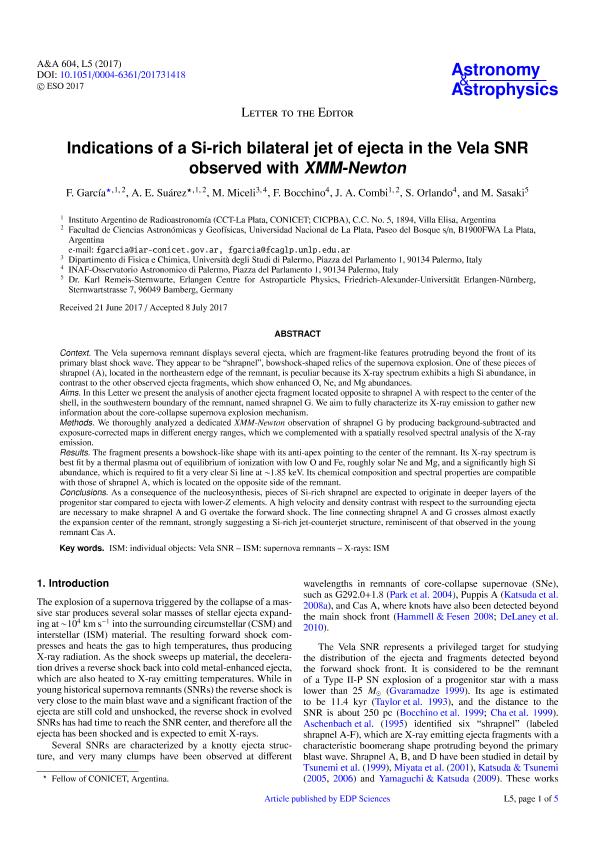Artículo
Indications of a Si-rich bilateral jet of ejecta in the Vela SNR observed with XMM-Newton
García, Federico ; Suárez, Alejandra Etelvina
; Suárez, Alejandra Etelvina ; Miceli, M.; Bocchino, F.; Combi, Jorge Ariel
; Miceli, M.; Bocchino, F.; Combi, Jorge Ariel ; Orlando, S.; Sasaki, M.
; Orlando, S.; Sasaki, M.
 ; Suárez, Alejandra Etelvina
; Suárez, Alejandra Etelvina ; Miceli, M.; Bocchino, F.; Combi, Jorge Ariel
; Miceli, M.; Bocchino, F.; Combi, Jorge Ariel ; Orlando, S.; Sasaki, M.
; Orlando, S.; Sasaki, M.
Fecha de publicación:
08/2017
Editorial:
EDP Sciences
Revista:
Astronomy and Astrophysics
ISSN:
0004-6361
Idioma:
Inglés
Tipo de recurso:
Artículo publicado
Clasificación temática:
Resumen
Context. The Vela supernova remnant displays several ejecta, which are fragment-like features protruding beyond the front of its primary blast shock wave. They appear to be "shrapnel", bowshock-shaped relics of the supernova explosion. One of these pieces of shrapnel (A), located in the northeastern edge of the remnant, is peculiar because its X-ray spectrum exhibits a high Si abundance, in contrast to the other observed ejecta fragments, which show enhanced O, Ne, and Mg abundances. Aims. In this Letter we present the analysis of another ejecta fragment located opposite to shrapnel A with respect to the center of the shell, in the southwestern boundary of the remnant, named shrapnel G. We aim to fully characterize its X-ray emission to gather new information about the core-collapse supernova explosion mechanism. Methods. We thoroughly analyzed a dedicated XMM-Newton observation of shrapnel G by producing background-subtracted and exposure-corrected maps in different energy ranges, which we complemented with a spatially resolved spectral analysis of the X-ray emission. Results. The fragment presents a bowshock-like shape with its anti-apex pointing to the center of the remnant. Its X-ray spectrum is best fit by a thermal plasma out of equilibrium of ionization with low O and Fe, roughly solar Ne and Mg, and a significantly high Si abundance, which is required to fit a very clear Si line at ∼1.85 keV. Its chemical composition and spectral properties are compatible with those of shrapnel A, which is located on the opposite side of the remnant. Conclusions. As a consequence of the nucleosynthesis, pieces of Si-rich shrapnel are expected to originate in deeper layers of the progenitor star compared to ejecta with lower-Z elements. A high velocity and density contrast with respect to the surrounding ejecta are necessary to make shrapnel A and G overtake the forward shock. The line connecting shrapnel A and G crosses almost exactly the expansion center of the remnant, strongly suggesting a Si-rich jet-counterjet structure, reminiscent of that observed in the young remnant Cas A.
Palabras clave:
Vela Snr
,
Supernova Remnants
,
X Rays
,
Insterstellar Medium
Archivos asociados
Licencia
Identificadores
Colecciones
Articulos(IAR)
Articulos de INST.ARG.DE RADIOASTRONOMIA (I)
Articulos de INST.ARG.DE RADIOASTRONOMIA (I)
Citación
García, Federico; Suárez, Alejandra Etelvina; Miceli, M.; Bocchino, F.; Combi, Jorge Ariel; et al.; Indications of a Si-rich bilateral jet of ejecta in the Vela SNR observed with XMM-Newton; EDP Sciences; Astronomy and Astrophysics; 604; 5; 8-2017; L5-L10
Compartir
Altmétricas



